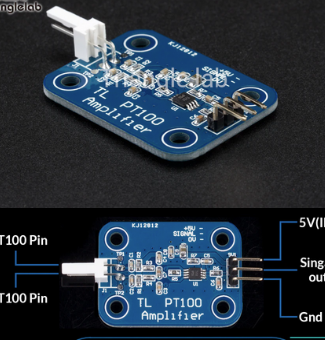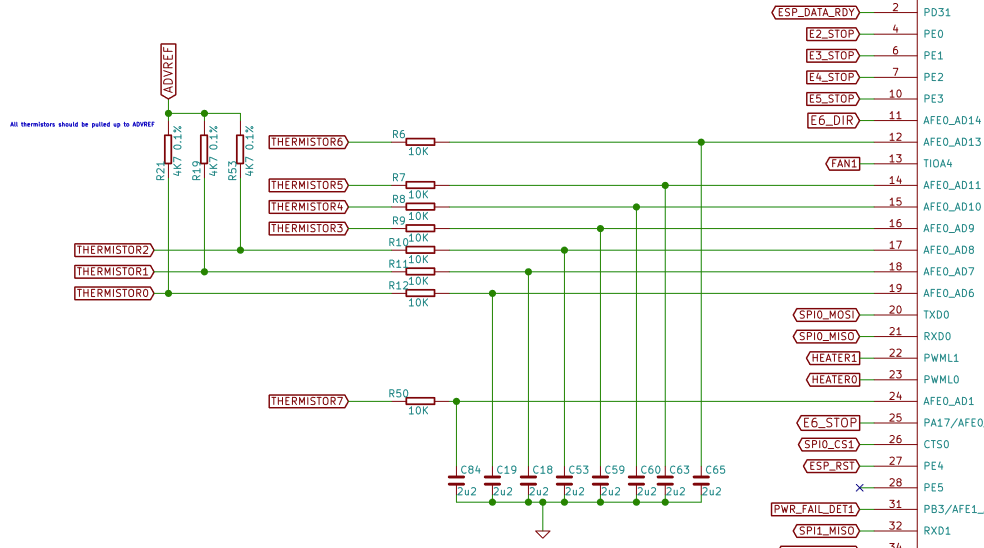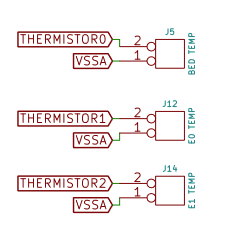IO pins capable of Analog input ?
-
I'm fairly new to duet so I am also new to the documentation but I did a search before posting so apologies if I missed something obvious. The only place where "analog" is mentioned on the hardware documentation talks how there is a separate input for z probe, so I assume that
zprobe.incan be linked to ADC, one can also assume all thermistor inputs can be linked to ADC too but nothing about other pins.I have a list of pins on a duet2ethernet and while I can see which ones support PWM output I have no clue which ones can support analog input.
zstopis the first one I'm interested in but general info must exist somewhere so I'd like a pointer to the information if it is available.thanks
;// Duet 2 and DueX heater outputs ; ;!bedheat ;!e0heat ;!e1heat ;exp.heater3, exp.8, !duex.e2heat, !duex.pwm1 ;exp.heater4, exp.13, !duex.e3heat, !duex.pwm2 ;exp.heater5, exp.18, !duex.e4heat, !duex.pwm3 ;exp.heater6, exp.23, !duex.e5heat, !duex.pwm4 ;exp.heater7, exp.31, !duex.e6heat, !duex.pwm5 ; ;// Duet 2 and DueX temperature inputs ;bedtemp ;e0temp ;e1temp ;e2temp, duex.e2temp, exp.thermistor3, exp.35 ;e3temp, duex.e3temp, exp.thermistor4, exp.36 ;e4temp, duex.e4temp, exp.thermistor5, exp.37 ;e5temp, duex.e5temp, exp.thermistor6, exp.38 ;e6temp, duex.e6temp, exp.thermistor7, exp.39 ; ;// Duet 2 and DueX fan outputs ;fan0 ;fan1 ;fan2 ;duex.fan3 ;duex.fan4 ;duex.fan5 ;duex.fan6 ;duex.fan7 ;duex.fan8 ; ;// Endstop inputs ;xstop ;ystop ;zstop ;e0stop ;e1stop ;exp.e2stop, exp.4 ;exp.e3stop, exp.9, duex.cs6 ;exp.e4stop, exp.14, duex.cs7 ;exp.e5stop, exp.19, duex.cs8 ;exp.e6stop, exp.24 ;duex.e2stop ;duex.e3stop ;duex.e4stop ;duex.e5stop ;duex.e6stop ; ;// Misc ;zprobe.in ;zprobe.mod ;duex.cs5 ;connlcd.encb, connlcd.3 ;connlcd.enca, connlcd.4 ;connsd.encsw, connsd.7 ;exp.pb6, exp.29, duex.pb6 ;duex.gp1 ;duex.gp2 ;duex.gp3 ;duex.gp4 ; ;// SPI CS ;spi.cs1 ;spi.cs2 ;spi.cs3 ;spi.cs4 ;spi.cs5, duex.cs5, exp.50 ;spi.cs6, duex.cs6, exp.9 ;spi.cs7, duex.cs7, exp.14 ;spi.cs8, duex.cs8, exp.19 ; ;// Pins on additional SX1509B expander ;sx1509b.0 ;sx1509b.1 ;sx1509b.2 ;sx1509b.3 ;sx1509b.4 ;sx1509b.5 ;sx1509b.6 ;sx1509b.7 ;sx1509b.8 ;sx1509b.9 ;sx1509b.10 ;sx1509b.11 ;sx1509b.12 ;sx1509b.13 ;sx1509b.14 ;sx1509b.15 -
The only pins on the Duet WiFi/Ethernet for which the standard firmware supports analog input are the zprobe.in pin and the pins with 'temp' in the name.
-
Thanks. That solves it.
-
@arhi Hello! Im looking for something along the similar to your query-- an analog pin for an input signal. Spicificly, I have a PT100 Amp board, temp. sensor that doesnt seem to use a MAX31865 chip. Triangle labs tl pt100 amplifier board. Deduced from their "official" AliExpress website, they state that only a single signal pin is required to recieve the one beseigheded 'signal' of analog discourse. Aside, a mere 5v and a 0v, or grounding pin secures the trios. Simple, right? Well, provided that this windy briefment is sufficient to satisfy any required knowlageable instruction and not interfere with the foreseeable future of the Duet 2 board I hope this might be the first, only informal documentation on attatching one of these things to a Duet 2. Please, anything further is always appreciaed and thank you for you time and responses.
-
@crookid probably better to start a new thread for this question. As for interfacing your PT100 board with the Duet 2, Duet3D sell a MAX31865 based PT100 daughter board; see https://docs.duet3d.com/Duet3D_hardware/Accessories/PT100_Temperature_Daughterboard
There are links on that page to the schematic and pin out. See also https://docs.duet3d.com/User_manual/Connecting_hardware/Temperature_connecting_PT100
Temperature daughterboards usually connect to the TEMP_DB connector on the Duet 2, so check the pin out on the Duet 2 wiring diagram too; see https://docs.duet3d.com/Duet3D_hardware/Duet_2_family/Duet_2_WiFi_Ethernet_Hardware_Overview#physical-connectionsIan
-
@crookid the 15$ board from TL is amplifier for PT100 that should be a copy of the ultimaker PT100 amplifier.


On the marlin you would connect the output directly to a analog input pin (no 4k7 voltage divider resistor) and you would set the RTD type to 20. If you look at Marlin source:
https://github.com/MarlinFirmware/Marlin/blob/57ca996c31e39b6935e2a24451040fa4379dc23e/Marlin/Configuration.h#L515
you see that* 20 : Pt100 with circuit in the Ultimainboard V2.x with mainboard ADC reference voltage = INA826 amplifier-board supply voltage. * NOTE: (1) Must use an ADC input with no pullup. (2) Some INA826 amplifiers are unreliable at 3.3V so consider using sensor 147, 110, or 21.so, in order to use this amp board (from triangle labs or from ultimaker or ..) you need clear analog input pin on the DUET.
If we look at the duet schematic:


the thermistor0,1,2 have 4k7 to advref (pullup/voltage divider) so you cannot use them, but you should be able to use any of the thermistor4-7 pins to feed in the output of that amplifier board.
That should work wrt how to connect. Now, how to configure PT100 amp in the firmware to show proper temp values - I have no clue, someone else will have to step in
-
@arhi Finding this Thermistor pin to be the one. As listed in the Hardware and Connections of the https://docs.duet3d.com/Duet3D_hardware/Duet_2_family/Duet_2_WiFi_Ethernet_Hardware_Overview#physical-connections: EXPANSION HEADER THERM7 (pin 39) e6temp, exp.thermistor7, exp.39 duex.e6temp. Wish I knew basic HTML and make this look like I have a clue.
-
@crookid you might be able to interface an analog PT100 amplifier board such as that one using the Linear Analog type of sensor supported by RRF in the M308 command. However, such solutions are not very accurate, because getting accurate readings from them requires several close-tolerance resistors on the amplifier board, the same voltage reference to be used on both the amplifier board and the printer control board, and very low ADC gain and offset errors in the ADC that read them. In contrast, the MAX31865 solutions require just one close tolerance resistor. We use a 0.1% tolerance resistor on the Duet3D PT100 daughter board. So if you've gone to the trouble of purchasing a PT100 sensor to get accurate temperature readings, IMO it really doesn't make sense to throw that accuracy away by using inaccurate electronics to measure it.